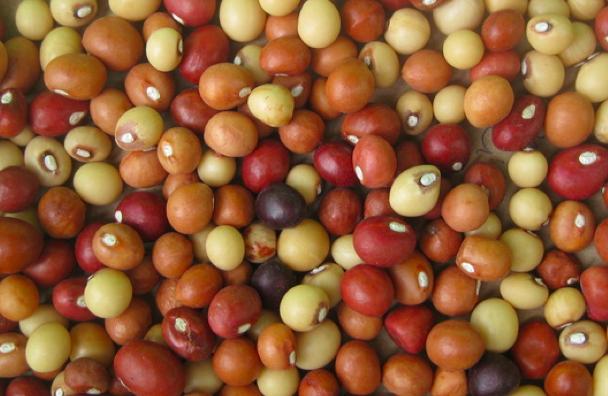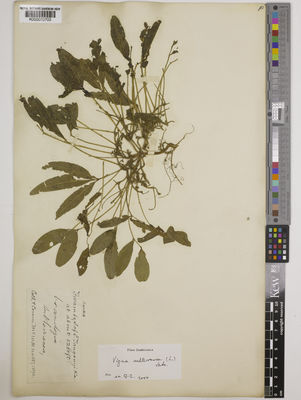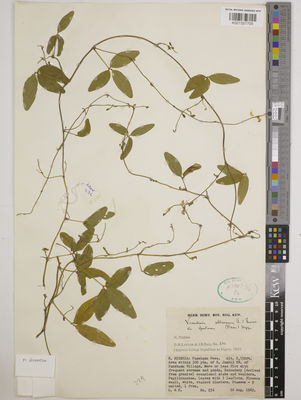Geography and distribution
Bambara groundnut most likely originated in north-eastern Nigeria and northern Cameroon, where it can still be found growing wild today. It is cultivated throughout tropical Africa and to a lesser extent in the tropical parts of the Americas, Asia and Australia.
Habitat
Bambara groundnut grows best in dry areas with sandy soils. It is also well suited to upland areas such as the highlands of Zambia and Zimbabwe. Bambara groundnut can produce a reasonably good yield in humid regions, although the dampness makes it susceptible to fungal diseases and the plant needs careful handling.
Description
Vigna subterranea is a leafy, annual, creeping legume with glabrous (hairless) leaves supported by a petiole 5-30 cm long. Each leaf is composed of three leaflets (trifoliolate) and can be up to 11 cm long.
Yellow flowers are clustered 1-3 on an unbranched axis, known as a raceme. They are papilionaceous, typical of species belonging to the subfamily Papilionoideae, and resemble, for example, the pea flower. The peduncle (the stalk supporting the raceme) is up to 3 cm long, hairy and after flowering it expands and bends downwards so that the fruits develop underground.
The ovary, which develops into the seed pod, contains 1-4 ovules. Once mature the seeds, which can be of various colours, are almost spherical and are 8-15 mm in diameter. Bambara groundnut has a deep taproot surrounded by lateral roots bearing nitrogen-fixing nodules.
Threats and conservation
Vigna subterranea is not considered to be threatened in the wild and its conservation status is of least concern (LC).
Uses
Bambara groundnut is cultivated mainly for its seeds which can be boiled, roasted or fried to make a delicious snack or mixed in with maize or plantains to serve as a meal. The seeds can be ground into flour after roasting and used to prepare porridge or they can be soaked, boiled and ground into a paste and used in fried or steamed dishes popularly eaten in Nigeria. The flour can also be used as a thickener in soups and stews and in Zambia it is commonly made into bread. Milk can be made from the seeds and fermented products similar to tempeh and dawadawa can be prepared.
Besides being a food crop, the seeds and leafy shoots of bambara groundnut, which are rich in protein and phosphorus make good fodder for pigs and poultry.
Bambara groundnut also has a number of medicinal uses. In Senegal:
leaf preparations are applied as a poultice for infected wounds and abscessesleaf sap is applied to the eyes as a treatment for epilepsypounded seeds mixed with water are used to treat cataractsthe roots of the plant can be taken as an aphrodisiac
Evidence suggests that high fibre foods such as bambara groundnut can reduce the incidence of heart disease and help to prevent colon cancer.
Bambara groundnut improves the quality of the soil because of its ability to fix nitrogen from the air. It is therefore a good companion in crop rotations.
Crop wild relatives of bambara groundnut
The Millennium Seed Bank and the Global Crop Diversity Trust are engaged in a ten-year project, called 'Adapting Agriculture to Climate Change'. The project aims to protect, collect and prepare the wild relatives of 29 key food crops, including bambara groundnut, so that they are available to pre-breeders for the development of new varieties that are more resilient to the effects of climate change.
Its ability to fix nitrogen and its resistance to high temperatures and drought makes bambara groundnut a valuable crop with enormous potential to be grown on a larger scale, providing food security for many more people.
Millennium Seed Bank: Seed storage
The Millennium Seed Bank Partnership aims to save plants worldwide, focusing on those plants which are under threat and those which are of most use in the future. Once seeds have been collected they are dried, packaged and stored at -20°C in Kew's Millennium Seed Bank vault.
Description of seeds: Average weight of 1,000 seeds = 585 g
Number of seed collections stored in the Millennium Seed Bank: One
Seed storage behaviour: Orthodox (the seeds of this plant can be dried to a low moisture content without significantly reducing their viability. This means they are suitable for long-term frozen storage)
Germination testing: Successful
This species at Kew
Pressed and dried specimens of bambara groundnut are held in Kew's Herbarium, where they are available to researchers by appointment. Details and images of some of these specimens can be seen online in Kew's Herbarium Catalogue.




